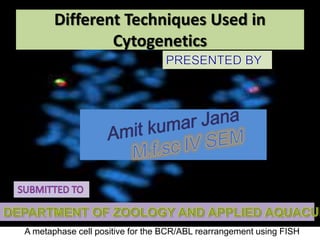
Different techniques used in cytogenetics
- 1. A metaphase cell positive for the BCR/ABL rearrangement using FISH Different Techniques Used in Cytogenetics
- 2. Introduction & Definition • Cytogenetics is a branch of genetics that is concerned with the study of the structure and function of the cell, especially the chromosomes. It includes routine analysis of G- banded chromosomes, other cytogenetic banding techniques, as well as molecular cytogenetics such as Fluorescent In Situ Hybridization (FISH) and Comparative Genomic Hybridization (CGH).
- 3. History • Chromosomes were first observed in plant cells by Karl Wilhelm von Nägeli in 1842. Their behavior in animal (salamander) cells was described by Walther Flemming, the discoverer of mitosis, in 1882. The name was coined by another German anatomist, von Waldeyer in 1888. • In science books, the number of human chromosomes remained at 48 for over thirty years. New techniques were needed to correct this error. Joe Hin Tjio working in Albert Levan’s lab was responsible for finding the approach: • Using cells in culture • Pre-treating cells in a hypotonic solution, which swells them and spreads the chromosomes • Arresting mitosis in metaphase by a solution of colchicine • Squashing the preparation on the slide forcing the chromosomes into a single plane • Cutting up a photomicrograph and arranging the result into an indisputable karyogram.It took until 1956 until it became generally accepted that the karyotype of man included only 46 chromosomes.Rather interestingly, the greatapes have 48 chromosomes. Human chromosome 2was formed by a merger of ancestral chromosomes, reducing the number.
- 4. Techniques 1. Karyotyping 1. Slide preparation 2. Analysis 2. Fluorescent in situ hybridization 1. Slide preparation 2. Analysis
- 5. Techniques Karyotyping • Routine chromosome analysis (Karyotyping) refers to analysis of metaphase chromosomes which have been banded using trypsin followed by Giemsa, Leishmanns, or a mixture of the two. Several chromosome-banding techniques are used in cytogenetics laboratories. Quinacrine banding (Q-banding) was the first staining method used to produce specific banding patterns. This method requires a fluorescence microscope and is no longer as widely used as Giemsa banding (G-banding). Reverse banding, or R-banding, requires heat treatment and reverses the usual black-and-white pattern that is seen in G-bands and Q-bands. This method is particularly helpful for staining the distal ends of chromosomes. Other staining techniques include C-banding.
- 6. Slide Preparation • Cells from bone marrow, blood, amniotic fluid, cord blood, tumor, and tissues (including skin, umbilical cord, chorionic villi, liver, and many other organs) can be cultured using standard cell culture techniques in order to increase their number. • A mitotic inhibitor (colchicine, colcemid) is then added to the culture. This stops cell division at mitosis which allows an increased yield of mitotic cells for analysis. The cells are then centrifuged and media and mitotic inhibitor are removed, and replaced with a hypotonic solution. This causes the white blood cells or fibroblasts to swell so that the chromosomes will spread when added to a slide as well as lyses the red blood cells. After the cells have been allowed to sit in hypotonic solution, Carnoy's fixative (3:1 methanol to glacial acetic acid) is added. This kills the cells and hardens the nuclei of the remaining white blood cells. The cells are generally fixed repeatedly to remove any debris or remaining red blood cells. The cell suspension is then dropped onto specimen slides. After aging the slides in an oven or waiting a few days they are ready for banding and analysis.
- 7. Analysis Analysis of banded chromosomes is done at a microscope by a clinical laboratory specialist in cytogenetics (CLSp(CG)). Generally 20 cells are analyzed which is enough to rule out mosaicism to an acceptable level. The results are summarized and given to a board-certified cytogeneticist for review, and to write an interpretation taking into account the patients previous history and other clinical findings.
- 8. Fluorescent in situ hybridization Fluorescent in situ hybridization refers to using fluorescently labeled probe to hybridize to cytogenetic cell preparations. In addition to standard preparations FISH can also be performed on: 1. bone marrow smears 2. blood smears 3. paraffin embedded tissue preparations 4. enzymatically dissociated tissue samples 5. uncultured bone marrow 6. uncultured amniocytes 7. cytospin preparations Fig of FSH
- 9. Slide preparation • The slide is aged using a salt solution usually consisting of 2X SSC (salt, sodium citrate). The slides are then dehydrated in ethanol, and the probe mixture is added. The sample DNA and the probe DNA are then co-denatured using a heated plate and allowed to re-anneal for at least 4 hours. The slides are then washed to remove excess unbound probe, and counterstained with 4',6-Diamidino-2- phenylindole (DAPI) or propidium iodide.
- 10. Analysis • Analysis of FISH specimens is done by fluorescence microscopy by a clinical laboratory specialist in cytogenetics. For oncology generally a large number of interphase cells are scored in order to rule out low-level residual disease, generally between 200 and 1,000 cells are counted and scored. For congenital problems usually 20 metaphase cells are scored.
- 11. Future of cytogenetics • Advances now focus on molecular cytogenetics including automated systems for counting the results of standard FISH preparations and techniques for virtual karyotyping, such as comparative genomic hybridization arrays, CGH and Single nucleotide polymorphism arrays.
- 12. Conclusion • So far, no system can classify banded chromosomes as robustly and accurately as a skilled cytogeneticist, despite the millions of dollars that have been invested in automated karyotype analysis since 1968. Currently cytogenetics is paving its way into the molecular approaches in deciphering the structure, function and evolution of chromosomes. Still,conventional cytogenetics where routine banding techniques are employed remains a simple and popular technique to get an overview of the human genome. Routine banded karyotype analysiscan now be combined with M-FISH and other molecular techniques leading to moreprecise detection of various syndromes in children.